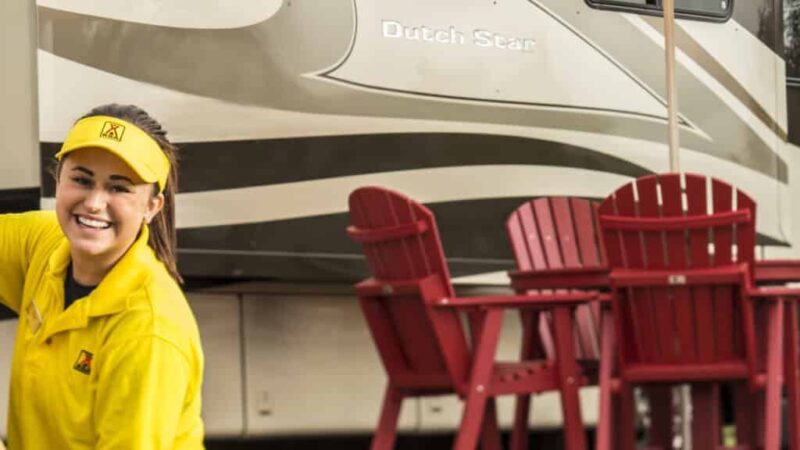Battery Charging
BATTERY CHARGING
By Steve Froese, F276276
I would like to introduce a reader email for discussion:
“I have a 2014 Fleetwood Bounder 34B with a parasitic drain on the coach batteries. I last drove it and charged them a week ago, and now they are reading down around 11 volts again on the dash voltmeter. On my rig, the coach batteries consist of two 6-volt batteries wired in series. They are both new — replaced right after winter. Please help. Thank you!”
Let’s walk through this issue to identify some tips. The type of batteries that provide starting current for motorhome engines are referred to as chassis batteries, while the batteries that power RV features such as lights, the water pump, and control boards are called the house or coach batteries.
Several things can cause parasitic drains on the house battery. The most common culprits are the propane detector, fridge humidity switch (if so equipped), and various electronics such as microwaves, clocks, digital radios, and televisions, to name a few. All these have electronic boards that consume power even when they are turned off. I have solar panels on my coach to prevent leak-down, but I always activate my battery disconnect if the RV will be parked for more than a few weeks.
However, even the disconnect does not remove all loads. Most notably, the propane detector is not typically wired through the disconnect. This detector should always be turned off during storage. Some RVs have a power switch for the propane detector, but if yours does not, removing the fuse is usually the best way to shut it down. Side note: I also recommend removing the batteries from remote controls, smoke detectors, and other electronic devices. This helps avoid battery corrosion. Purchase new batteries for these devices when you take your RV out of storage.
Neither the converter nor the generator is the most efficient way to charge the batteries. The generator charges the batteries simply by providing power to the converter or inverter/charger. A converter has a relatively low charge rate, and if the batteries have a low state of charge (SOC), the converter may not be able to fully recover them. The exception to this is if your RV has an inverter/charger; in that case, running the generator will activate the inverter charge function, which is usually more than 100 amps. This will provide a good, strong charge current.
In the case of a motorhome, the engine alternator is an effective way to charge the batteries. Like an inverter/charger, it probably has a charging output of at least 100 amps, which provides a nice high charge rate.
Here are some things to bear in mind regarding charging your chassis and house batteries:
- X-If you drive the RV for several hours, charging off the alternator should do the trick. The same concept applies to travel trailers, which will charge through the 7-way plug line.
- Running the generator for a brief time will do little, similarly with plugging the coach into shore power, unless you have an inverter/charger.
- If the house batteries are not charging from the alternator, or if the chassis batteries are not charging from shore power, the battery isolator is probably not working. The best thing to do in this situation is to put a voltmeter across the battery terminals with the engine running, and then do this while on shore power (just not at the same time). Ensure the battery voltage is around 14 volts DC whenever one of these sources is active. If you do not have the same voltage on all batteries, it’s likely that the battery isolation solenoid is not closing, which would facilitate the charge current to all batteries. Advanced troubleshooting should be performed on the isolator circuit.
- If the batteries are charging from the alternator and shore power but not from the generator, the generator may have a tripped breaker, or be faulty. Many people do not realize there are breakers on the generator itself. The transfer switch could also have an issue.
- If the batteries are not charging while on shore power, the issue could be related to the incoming power (possibly no power at the pedestal), a blown converter or inverter fuse, or a damaged converter or inverter. Again, advanced troubleshooting is required.
- If the battery disconnect switch is active (batteries disconnected), they likely will not charge, so make sure the batteries are NOT disconnected when you are trying to charge them.
- Batteries could also be damaged or dead from old age. If they are new, this is unlikely. Note that if the batteries are not maintenance-free, you will need to keep the electrolyte level full. Failure to do this can result in the water boiling off and therefore ruining the batteries. This is a common problem when RVs are left plugged in for extended periods, as standard converters may lack a “float charge” function, so the batteries may boil due to overcharging.
The main point is that different charging fail scenarios require different diagnostics. You could purchase a stand-alone battery charger and use it to fully charge the batteries. It is not a bad idea to carry one of these in the event of any of the failures indicated above. Plugging the battery charger into an RV receptacle or park pedestal can help prevent you from being stranded or not having any 12-volt power in the RV.
During storage, it is a good idea to remove, clean, and store the batteries in a cool and dry place once they are charged.
Issues with the 12-volt electrical system are usually easy to diagnose and repair as long as you understand that different symptoms may require very different troubleshooting. Seek professional assistance if you encounter an issue with your RV that you cannot resolve yourself. You may also feel free to reach out to me at [email protected].
The post Battery Charging appeared first on Family RVing Magazine.
Source: https://familyrvingmag.com/2023/06/21/battery-charging/



